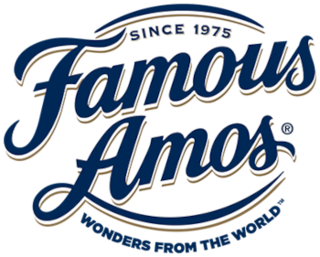
A cookie or biscuit is a baked snack or dessert that is typically small, flat, and sweet. It usually contains flour, sugar, egg, and some type of oil, fat, or butter. It may include other ingredients such as raisins, oats, chocolate chips, or nuts.

Altoids are a brand of mints, sold primarily in distinctive metal tins. The brand was created by the London-based Smith & Company in the 1780s, and became part of the Callard & Bowser company in the 19th century. Their advertising slogan is "The Original Celebrated Curiously Strong Mints", referring to the high concentration of peppermint oil used in the original flavour lozenge. The mints were originally conceived as a lozenge intended to relieve intestinal discomfort.

Kit Kat is a chocolate-covered wafer bar confection created by Rowntree's of York, England. It is produced globally by Nestlé, except in the United States, where it is made under licence by the H. B. Reese Candy Company, a division of the Hershey Company.

The Keebler Company is an American cookie and former cracker manufacturer. Founded in 1853, it has produced numerous baked snacks, advertised with the Keebler Elves. Keebler had marketed its brands such as Cheez-It, Chips Deluxe, Club Crackers, E.L. Fudge Cookies, Famous Amos, Fudge Shoppe Cookies, Murray cookies, Austin, Plantation, Vienna Fingers, Town House Crackers, Wheatables, Sandie's Shortbread, Pizzarias Pizza Chips, Chachos and Zesta Crackers, among others. Keebler slogans have included "Uncommonly Good" and "a little elfin magic goes a long way". Tom Shutter and Leo Burnett wrote the familiar jingle.

Ferrero International SpA, more commonly known as Ferrero Group or simply Ferrero, is an Italian multinational company with headquarters in Alba. Ferrero is a manufacturer of branded chocolate and confectionery products, and the second biggest chocolate producer and confectionery company in the world. Ferrero SpA is a private company owned by the Ferrero family and has been described as "one of the world's most secretive firms".

The brigadeiro is a traditional Brazilian dessert. The origin of the dessert is uncertain, but the most common theory is that it was created by a confectioner from Rio de Janeiro, Heloísa Nabuco de Oliveira, to promote the presidential candidacy of Eduardo Gomes. It is made of condensed milk, cocoa powder, butter, and chocolate sprinkles covering the outside layer.
Butterfinger is a candy bar manufactured by the Ferrara Candy Company, a subsidiary of Ferrero. It consists of a layered crisp peanut butter core covered in a "chocolatey" coating. It was invented by Otto Schnering of the Curtiss Candy Company in 1923. A popularity contest chose the name.

Reese's Peanut Butter Cups are an American candy by the Hershey Company consisting of a peanut butter filling encased in chocolate. They were created on November 15, 1928, by H. B. Reese, a former dairy farmer and shipping foreman for Milton S. Hershey. Reese was let go from his job with Hershey when the Round Barn which he managed was shut down for cost-saving measures. He subsequently decided to start his own candy business. Reese's are a top-selling candy brand worldwide, with $3.1 billion in annual sales.

A tin box is a tinplate container. Tinplate metal is primarily steel with a very thin tin coating. Tin-free steel is also used. In some cultures, these boxes or cans are referred to as "tin boxes" or sometimes even "tins". Many “tin boxes” have hinged or removable lids or covers. Some people collect tin boxes as a hobby.

Fox's Biscuits is an English biscuit manufacturer, founded by the Fox family in Batley, West Yorkshire, in 1853 and currently a subsidiary of Ferrero. The head office and main factory are based in the town, and the company has another site in Wesham in Lancashire. Its biscuits are exported to Europe, North America and Asia.

Famous Amos is a brand of cookies founded in Los Angeles in 1975 by Wally Amos.

Arnott's Group is an Australian producer of biscuits and snack food. Founded in 1865 by William Arnott, they are the largest producer of biscuits in Australia and a subsidiary of KKR.

Chips Deluxe is a brand of cookies made by the Keebler Company and distributed in the United States.

Mother's Cookies is a food brand owned by Italian conglomerate Ferrero Group. Mother Cookies began as a bakery based in Oakland, California, that operated from 1914 to 2008. A sister company, Archway Cookies of Battle Creek, Michigan, was founded in 1936. Both Mother's Cookies and Archway declared bankruptcy in 2008. At its height, the company distributed cookies throughout the United States, and was one of the leading cookie makers in the country. The Kellogg Company acquired the Mother's Cookies trademark and recipes in December 2008 and brought the brand back to West Coast grocery store shelves on May 14, 2009.

E.L. Fudge is an American snack food introduced in 1986 and manufactured by the Keebler Company, a subsidiary of Ferrero SpA. They are butter-flavored shortbread sandwich cookies with a fudge creme filling. The company describes their shape as "elfin", though it is actually various Keebler elves, each identified with a name tag.

The Campbell Soup Company, doing business as Campbell's, is an American company, most closely associated with its flagship canned soup products; however through mergers and acquisitions, it has grown to become one of the largest processed food companies in the United States with a wide variety of products under its flagship Campbell's brand as well as other brands including Pepperidge Farm, Snyder's of Hanover, V8, and Swanson. With its namesake brand Campbell's produces soups and other canned foods, baked goods, beverages, and snacks. It is headquartered in Camden, New Jersey.

Butter cookies, also known as Danish butter cookies, are cookies originating in Denmark consisting of butter, flour, and sugar. They are similar to shortbread cookies.

Barquillo is a crispy rolled wafer pastry originating in Spain. It is made from the basic cookie ingredients of flour, sugar, egg whites and butter rolled out thinly and then shaped into a hollow cylinder or a cone. It was traditionally sold by roadside vendors known as barquilleros who carried a characteristic red roulette tin. It was introduced to Latin America and the Philippines during colonial times. In Spain and former Spanish colonies, barquillos are commonly regarded as a type of Christmas cookie. It is also popular during various fiestas. It spread to neighboring countries and today is extremely popular in East and Southeast Asian countries.

Hello Robin is a woman-owned bakery with two locations in Seattle, in the U.S. state of Washington. The original bakery opened on Capitol Hill in 2013. A second location opened at University Village in 2020.



















